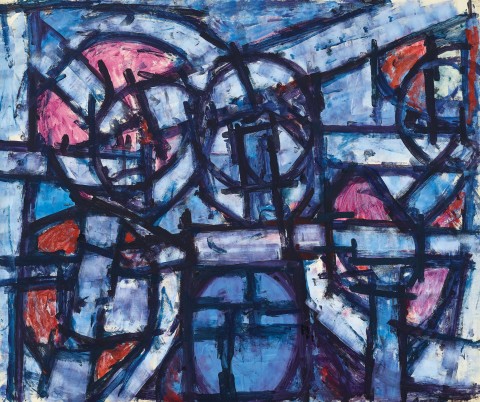STRUCTURAL CONCEPT, c.1972 – 74
ROGER KEMP
synthetic polymer paint on paper on hardboard
152.5 x 182.5 cm
signed lower right: Roger Kemp
signed on artist's label attached verso with title, date, medium, dimensions and artist’s name
Bellas Gallery, Brisbane
Private collection, Brisbane
Untitled, illus. in Hurlston, D et al., Roger Kemp: Visionary Modernist, National Gallery of Victoria, Melbourne, 2019, pp.122 – 23.
Untitled (Sequence), 1971 - 74, acrylic on paper, 152.0 x 480.0 cm illus. in Heathcote, C., Quest for Enlightenment: The Art of Roger Kemp, Macmillan, Melbourne, 2007, pp.132 –33.
Structural Concept, c.1972 – 74 conveys so directly that dynamic period when Sydney and Melbourne surged with cosmopolitan confidence. It was painted when Roger Kemp had returned to his homeland after two years working and exhibiting in Britain. The artist was struck at how these familiar metropolises were now so bristling and alive. Office towers were shooting up, freeways were pulsing with traffic, high speed computers and global telecommunications propelled business, crowded streets were energised with positive determined people. This upbeat pace was most apparent when Kemp moved into a city studio with several artists — high-rise construction was going up around them.
Structural Concept shows visual echoes of this changing Australia worked into Kemp’s geometric art. He assembled a structure using a palette of spatial blue, rich reds inflected with earthy browns or spicy purples, taut white rods, then firm black lines which tie together a dominant configuration. Kemp set in these forms using the new artists’ sponge rollers shipped from overseas, then completed his work with traditional linear brushwork to clarify the geometry, bringing forth suggestions of a pulsing new cityscape.
Kemp does not abandon his former cosmic geometry, which reaches back to Pythagoras, Galileo and Newton, but he infuses the tensile bars and swerving arcs with that experiential immediacy of Australian cities, how enduring ratios and ageless forms were reappearing in steel, glass and concrete. With its lively freshness, we see in Structural Concept unmistakable suggestions of streets buzzing with redevelopment, of skinny cranes and girders rising on high, of noisy traffic funnelled below, of Melbourne’s bossy BHP tower, and of thrilling Sydney projects by visionary architects like Harry Seidler.
This stress was instantly recognised. Kemp’s work was praised for embodying the spirit of a progressive nation which could hold its own on the cultural front—and the artist found himself lifted to the front rank of Australian painting. The Sydney Biennale, a festival to showcase the best international artists, was launched in 1973. Kemp was chosen to represent Australia in the inaugural show, his geometric paintings being installed within Sydney’s glistening Opera House. The Prime Minister, Gough Whitlam, also had ambitions to send to Europe an official exhibition of the nation’s ten foremost artists. A group of Kemp’s new paintings were included in that landmark 1974 show, Ten Australians, which toured France, Germany, Italy and Britain. As well the Visual Arts Board commissioned a documentary film on Kemp and this new work, which was screened nationally on ABC television, then Melbourne University offered him a big solo show to fill its just opened gallery.
Structural Concept, which was painted during this intense creative period, shows Roger Kemp in top form. One can appreciate why the Australian’s critic Christopher Allen was transfixed by a room filled with these mature works in the National Gallery of Victoria’s Kemp retrospective late last year (among them an untitled companion piece to Structural Concept). “These paintings look more beautiful and impressive,” Allen declared in his review, insisting how in visual terms this peak in Kemp’s production “can be said, without exaggeration, to be breathtaking.”1
1. Allen, C, ‘Rethinking an artist cast in a whole new light’, Weekend Australian, 11—12 Jan 2020
DR CHRISTOPHER HEATHCOTE
